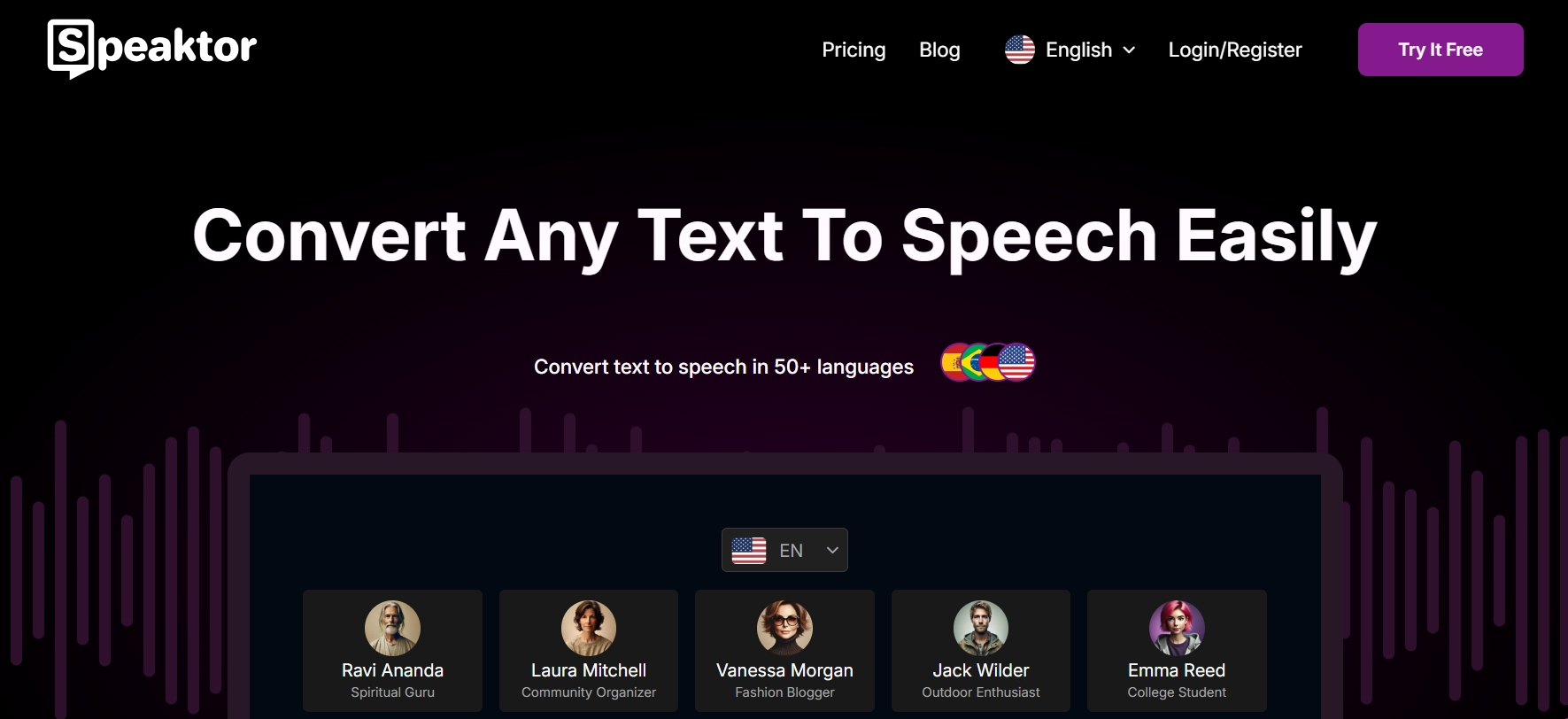
Voice Advertising: Definition, Importance, and Tools
Table of Contents
- What Makes Voice Advertising Essential for Modern Marketing Strategies?
- How Has AI Voice Technology Evolved in Recent Years?
- What Technological Breakthroughs Drive Modern AI Voice Generation?
- Voice Marketing Strategies: Which Approaches Drive Successful Campaigns?
- How Can Brands Optimize Content for Voice Search Discovery?
- How Do Effective Voice-Enabled Ads Differ from Traditional Advertising?
- What Creates a Compelling Voice Brand Identity?
- Text-to-Speech Advertising Tools: Which Options Provide the Best Marketing Solutions?
- Speaktor
- What Other Text-to-Speech Solutions Serve Voice Advertising Needs?
- Conclusion
Turn Texts into Speech and Read Aloud
Table of Contents
- What Makes Voice Advertising Essential for Modern Marketing Strategies?
- How Has AI Voice Technology Evolved in Recent Years?
- What Technological Breakthroughs Drive Modern AI Voice Generation?
- Voice Marketing Strategies: Which Approaches Drive Successful Campaigns?
- How Can Brands Optimize Content for Voice Search Discovery?
- How Do Effective Voice-Enabled Ads Differ from Traditional Advertising?
- What Creates a Compelling Voice Brand Identity?
- Text-to-Speech Advertising Tools: Which Options Provide the Best Marketing Solutions?
- Speaktor
- What Other Text-to-Speech Solutions Serve Voice Advertising Needs?
- Conclusion
Turn Texts into Speech and Read Aloud
Voice advertising creates immersive audio experiences through voice-activated devices, digital voice assistants, and smart speakers, revolutionizing how brands connect with audiences. Voice advertising technology enables marketers to deliver promotional content through audio channels when consumers increasingly seek alternatives to screen-based interactions. Voice-enabled ads demonstrate higher engagement rates compared to traditional visual advertisements, establishing voice marketing strategies as essential components of modern digital marketing campaigns. Consider using a read aloud platform to enhance your audio content.
What Makes Voice Advertising Essential for Modern Marketing Strategies?
Voice advertising represents a fundamental shift in digital marketing approaches, providing brands with unique opportunities to establish connections in audio-only environments. The significance of voice advertising stems from multiple converging factors creating favorable conditions for audio marketing growth.
Several elements contribute to voice advertising in the current marketing landscape:
- Screen fatigue reduction among consumers seeking alternatives to visual digital experiences
- Multitasking capabilities allow engagement during activities when screens remain impractical
- Accessibility benefits by making content available to diverse audience segments
- Conversational AI improvements reaching unprecedented levels of natural language sophistication
- Pandemic acceleration is increasing consumer comfort with touchless technology interaction
The voice advertising market demonstrates remarkable growth trajectories, with projections reaching $19.4 billion by 2027 at a 19.4% CAGR. The widespread adoption of digital voice assistants by approximately 128 million Americans monthly creates extensive brand engagement opportunities through voice commerce channels. Voice advertising effectiveness metrics reveal 24% higher recall rates compared to traditional display advertising, confirming the potency of voice-enabled ads in marketing strategies.

How Has AI Voice Technology Evolved in Recent Years?
The transformation of AI voice technology from mechanical, robotic speech to remarkably human-like voice synthesis represents one of the most significant technological evolutions in modern digital communication. AI voice generators have progressed from novelty applications to sophisticated speech synthesis tools capable of creating authentic-sounding speech that conveys brand personality and emotional nuance through voice-enabled ads.
The development timeline spans from basic phoneme synthesis techniques in the 1970s to neural network-based models powering today's advanced text-to-speech advertising solutions. Quality improvements in AI voice technology demonstrate substantial progress, with modern AI voice generators scoring above 90% in human similarity tests compared to approximately 40% a decade ago. Processing efficiency improvements have reduced generation time from minutes to milliseconds per utterance, enabling real-time applications for digital voice assistants.
The global text-to-speech market demonstrates robust expansion, with projections reaching $5.0 billion by 2026 as use cases evolve from accessibility applications to mainstream marketing adoption across voice commerce channels, including text to speech android.

What Technological Breakthroughs Drive Modern AI Voice Generation?
The earliest synthetic voices produced instantly recognizable machine-generated output with choppy cadence, unnatural pronunciation, and distinctive robotic qualities, limiting practical applications. Modern AI voice technology delivers natural-sounding speech with appropriate intonation, emotional inflection, and human-like timing suitable for voice advertising campaigns across multiple audio marketing channels.
The evolution of AI voice technology has progressed through several technological approaches:
- Concatenative synthesis methods stitch together pre-recorded human speech segments
- Parametric synthesis utilizing mathematical models for generating more natural-sounding speech
- Deep learning approaches with neural networks revolutionized voice quality around 2016
- Emotional modeling incorporating appropriate emotional tones for context-specific applications
- Personalization capabilities enabling voice cloning and customization at scale for branded content
Machine learning advancements remain the driving force behind today's remarkably lifelike AI voices for text-to-speech advertising. Advanced algorithms analyze vast datasets of human speech to identify patterns in pronunciation, rhythm, and intonation, then apply these learnings to generate increasingly natural-sounding voices suitable for voice-enabled ads.
Key machine learning innovations powering modern AI voice technology include:
- Neural text-to-speech systems are creating more natural prosody and intonation patterns
- WaveNet technology utilizes convolutional neural networks to model raw audio waveforms
- Transfer learning techniques allow voice models to adapt to new languages or accents
- Attention mechanisms capturing long-range dependencies in speech for improved coherence
- Generative adversarial networks are continuously improving through competitive learning processes
Voice Marketing Strategies: Which Approaches Drive Successful Campaigns?
Voice marketing strategies require specific approaches tailored to the unique characteristics of audio media and voice-enabled devices. Brands must reconsider traditional marketing techniques, focusing on conversational engagement, sonic branding, and content optimized for voice discovery through digital voice assistants and voice commerce platforms.
The most effective voice marketing strategies incorporate:
- Conversational design principles for natural interactions
- Sonic branding elements establish audio recognition
- Voice search optimization for discovery enhancement
- Multimodal approaches connecting audio and visual experiences
- Personalization capabilities that adapt to individual preferences
Strategy adoption metrics indicate 76% of marketers plan to increase voice marketing budgets in the coming year. Effectiveness measurements reveal that brands implementing voice marketing strategies report 31% higher customer engagement rates compared to traditional approaches. ROI analysis demonstrates voice-optimized content produces 2.7x better conversion rates for compatible products in voice commerce environments. Integration importance remains paramount, with 88% of successful voice marketers incorporating voice within broader marketing frameworks rather than isolated initiatives.
How Can Brands Optimize Content for Voice Search Discovery?
Voice search optimization represents a critical component of effective voice advertising strategies as consumers increasingly utilize digital voice assistants for information retrieval and product discovery. Optimizing content for voice discovery maintains visibility and captures customer attention at crucial moments of interest in the voice commerce journey.
Effective voice search optimization techniques include:
- Conversational keyword integration focusing on natural language phrases rather than traditional keywords
- Question-focused content structures addressing common queries users pose to digital voice assistants
- Featured snippet targeting, creating content formats likely selected for voice assistant responses
- Local SEO emphasizes optimizing for "near me" and location-based voice queries in voice commerce contexts
- Schema markup implementation utilizing structured data to help voice assistants comprehend content relevance
The emergence of voice search necessitates the adaptation of traditional SEO approaches to accommodate the distinctive characteristics of voice queries. Voice searches typically contain longer phrases, conversational language, and question formats compared to text-based searches. Successful voice search optimization strategies account for these differences by creating content specifically designed for voice discovery through digital voice assistants.
How Do Effective Voice-Enabled Ads Differ from Traditional Advertising?
Voice-enabled ads demand different creative approaches than visual or text-based advertisements. The most effective voice advertising leverages the intimate nature of audio marketing, creates interactive experiences, and provides clear conversion pathways for audience engagement in voice commerce environments.
Best practices for creating conversion-focused voice-enabled ads include:
- Conversational scripting utilizes natural, spoken language rather than formal marketing copy
- Sonic branding development incorporating distinctive audio cues, reinforcing brand recognition
- Response optimization,crafting concise answers suitable for digital voice assistant environments
- Interactive element inclusion adding voice-activated commands within advertisement structures
- Multimodal design creates complementary experiences across audio and visual elements for comprehensive engagement
Voice advertising effectiveness stems partly from the distinctive psychological impact of audio content compared to visual media. Voice creates perceived intimacy, establishes emotional connections through tone variations, and commands attention without competing visual distractions. Brands leveraging these unique characteristics of voice-enabled ads develop more memorable and impactful marketing communications.
What Creates a Compelling Voice Brand Identity?
Just as visual branding requires consistency, developing a strong voice branding identity demands a coherent approach to how brands sound across all customer touchpoints in audio marketing channels. Well-developed voice brand identity creates recognition and builds trust through consistent audio experiences across digital voice assistants and other voice-enabled platforms.
Essential elements of a strong voice brand identity include:
- Voice persona development, creating consistent character representations for the brand
- Tone guidelines establishing how the brand voice should convey different message types
- Audio logo development involves designing distinctive sounds serving as audio signatures
- Voice selection, choosing appropriate voice characteristics reflecting brand values
- Linguistic pattern definition creating consistent vocabulary, phrases, and speech patterns
Voice brand identity serves multiple strategic purposes beyond simple recognition. Effective voice branding creates emotional connections, enhances memorability, reinforces brand values, differentiates from competitors, and ensures consistent experiences across all touchpoints. Organizations establishing comprehensive voice brand identity guidelines position themselves advantageously for the voice-first future of digital marketing.
Text-to-Speech Advertising Tools: Which Options Provide the Best Marketing Solutions?
Text-to-speech advertising technology has evolved from utilitarian accessibility applications to sophisticated marketing assets, enabling brands to create high-quality audio content efficiently at scale. Modern text-to-speech solutions offer unprecedented flexibility, quality, and customization options for marketers implementing voice advertising strategies.
The leading text-to-speech advertising tools for marketing applications include:
- Speaktor - Enterprise-grade multilingual voice generation platform
- Amazon Polly - AWS-based developer-focused text-to-speech service
- Google Text-to-Speech - Neural voice synthesis with WaveNet technology
- Microsoft Azure TTS - Enterprise text-to-speech with extensive voice options
- Murf.ai - AI voice generator focused on commercial applications
Tool Comparison | Key Strength | Best For | Price Model | Special Feature |
|---|---|---|---|---|
Speaktor | Multilingual support | Global campaigns | Subscription | Team collaboration |
Amazon Polly | Developer API | Technical teams | Pay-per-use | SSML support |
Google TTS | Neural voices | Google integration | Tiered usage | WaveNet technology |
Azure TTS | Enterprise security | Large organizations | Usage-based | Neural voices |
Murf.ai | User-friendly | Marketing teams | Credit-based | Commercial rights |
Text-to-speech adoption metrics show 64% of enterprise marketing teams now utilize text-to-speech in content production workflows. Production efficiency measurements indicate that text-to-speech reduces audio production time by up to 80% compared to traditional recording processes for voice advertising assets. Quality perception research reveals 72% of consumers cannot reliably distinguish high-end text-to-speech from human voices in audio marketing contexts.

Speaktor
Speaktor stands out as the premier solution for creating professional-quality voice content with unmatched flexibility, language support, and team collaboration capabilities for voice advertising campaigns. This web-based platform transforms written content into natural-sounding speech usable across various audio marketing channels and voice-enabled ads.
Pros
- Comprehensive multilingual support with over 50 languages enables global voice marketing strategies
- Intuitive user interface requires minimal technical expertise for marketing team adoption
- Advanced voice customization options create distinctive brand voice identities
- Secure team collaboration features facilitate workflow management across marketing departments
- Flexible file input formats accommodate various content sources for voice conversion
- High-quality neural voices deliver natural-sounding results for professional voice-enabled ads
- Scalable pricing structure adapts to organizations of different sizes and usage requirements
Cons
- Premium pricing may exceed budget constraints for smaller marketing teams
- Advanced customization features present steeper learning curves for new users
- Enterprise focus may include unnecessary features for simple voice marketing projects
- Limited direct integration with some popular marketing platforms requires manual workflow steps
- Higher quality voices require greater processing time compared to basic options
The key Speaktor features essential for effective voice advertising include:
- Multilingual capabilities supporting over 50 languages for global marketing campaigns
- Professional voiceover creation generating high-quality recordings with multiple speaker options
- Language translation converting and generating audio in various languages automatically
- Flexible input options uploading PDF, TXT, or DOCX files directly into the platform
- Team collaboration organizing files in secure workspaces with role-based permissions
- Customizable download options exporting audio in MP3 or WAV formats based on quality requirements
- Excel file support creating voiceovers from structured data for product catalogs or announcements
Speaktor implementation follows a straightforward process designed for marketing team efficiency: account registration, content upload, voice and language selection, audio generation, quality review, and format-specific export for distribution across voice advertising channels. This streamlined workflow enables rapid production of professional voice content without technical expertise requirements.
What Other Text-to-Speech Solutions Serve Voice Advertising Needs?
While Speaktor offers comprehensive voice generation capabilities for voice advertising, several alternative solutions serve specific niches within the voice advertising ecosystem. Understanding the strengths and limitations of each option helps marketers select appropriate tools for specific voice marketing strategies.
Amazon Polly
Amazon Polly provides AWS-based text-to-speech with SSML support for technical implementations of voice-enabled ads. The service offers developer-friendly API access and pay-as-you-go pricing structures suitable for programmatic voice advertising applications.
Pros
- Robust API integration capabilities for custom voice application development
- Pay-per-use pricing model eliminates upfront investment requirements
- SSML support enables detailed control over speech characteristics
- AWS ecosystem integration simplifies deployment within existing infrastructure
- High reliability and scalability for enterprise-level voice advertising campaigns
- Extensive language support facilitates global voice marketing initiatives
Cons
- Requires technical expertise for effective implementation
- Limited user-friendly interfaces for marketing professionals without development skills
- Voice customization options less extensive than specialized marketing platforms
- Brand voice development requires additional technical configuration
- Learning curve steeper for non-technical marketing teams
- Basic voices less natural-sounding than premium neural voice alternatives
While powerful for technical teams, Amazon Polly presents limitations in voice customization options and requires technical implementation resources. The service best serves developers building voice applications within AWS infrastructure for digital voice assistants.
Google Text-to-Speech: Neural Voice Quality
Google Text-to-Speech delivers cloud-based speech synthesis with advanced WaveNet voices suitable for voice advertising applications requiring exceptional natural quality. The service offers high-quality neural voices and seamless Google ecosystem integration advantages.
Pros
- Superior WaveNet neural voice technology produces exceptionally natural-sounding speech
- Seamless integration with other Google Cloud services and marketing platforms
- Extensive language and voice variety supports diverse voice advertising campaigns
- Strong multilingual capabilities facilitate global voice marketing initiatives
- Consistent improvement through Google's ongoing AI research advancements
- Reliable performance for enterprise-scale voice advertising implementations
Cons
- Less intuitive interface for marketing professionals without technical backgrounds
- Limited customization options for creating distinctive brand voice identities
- Tiered pricing structure potentially increases costs for high-volume voice advertising
- Requires development resources for full implementation in marketing workflows
- Limited direct support for marketing-specific voice advertising use cases
- Integration complexity for non-Google marketing technology stacks
Limitations include less intuitive interfaces for marketing teams and restricted branding options compared to specialized voice advertising solutions. The platform best serves organizations already utilizing Google Cloud Platform for broader marketing technology infrastructure.
Conclusion
Voice advertising represents a fundamental shift in brand-audience connections, moving beyond visual screen clutter to create more intimate, accessible, and engaging experiences through sound. As AI voice technology advances, the quality, flexibility, and effectiveness of voice marketing strategies will continually improve, establishing voice as an essential channel for progressive marketers. Organizations investing in voice capabilities now establish valuable competitive advantages as consumer adoption of voice interfaces accelerates across digital voice assistants and voice commerce platforms.
The journey toward voice-first marketing begins with understanding the technology landscape, developing appropriate voice marketing strategies, and selecting suitable tools for specific organizational objectives. Solutions like Speaktor provide accessible entry points for companies incorporating professional-quality voice content into marketing initiatives without specialized technical expertise requirements. By embracing voice advertising technologies today, forward-thinking brands position themselves advantageously for the audio-focused marketing landscape of tomorrow. Use Speaktor for Free now to elevate your audio advertisements!
Frequently Asked Questions
AI voice technology is revolutionizing marketing by enabling brands to create natural-sounding, high-quality audio content at scale without traditional recording costs or time constraints. This technology allows for personalized audio experiences, consistent brand voice across touchpoints, rapid content updates, and multilingual capabilities that were previously impractical or prohibitively expensive.
Speaktor distinguishes itself with support for over 50 languages, professional-quality voiceovers with multiple speaker options, intuitive team collaboration features, and a user-friendly interface designed specifically for marketers rather than developers. Unlike most alternatives that require technical expertise, Speaktor makes professional voice content creation accessible to marketing teams without specialized skills.
Voice-enabled ads can improve conversion rates by creating more engaging, interactive experiences that capture attention in ways visual ads cannot. They provide a direct response mechanism through voice commands, reduce friction in the customer journey by allowing hands-free interaction, and create more memorable brand experiences through the emotional connection of human-like voices and sound.
Voice search optimization differs from traditional SEO by focusing on conversational, question-based queries rather than short keywords, prioritizing featured snippet positioning, emphasizing local search intent, targeting longer-tail phrases that match natural speech patterns, and structuring content to directly answer specific questions in a conversational format.

